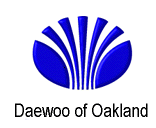| Home | Daewoo Automobiles | Why Choose Daewoo? | About Daewoo |
| Interactive Guide | Automotive Links | Contact Information | Site Map |

1967-1972
The story of Daewoo begins in 1967. Back then, the Daewoo Group was known as Daewoo Industrial Co., Ltd., a producer and exporter of textiles and textile products based in South Korea. Soon, Daewoo became successful enough exporting textiles to Singapore to establish its first overseas branch office in Sydney, Australia, and its first overseas subsidiary in Frankfurt, Germany. Exports by Daewoo grew from U$580,000 in 1967 to about U$40,000,000 in 1972. Because Daewoo was the second largest Korean exporter, it was given the "Order of Industrial Merit, Gold Tower" by the Korean Government.
1973-1975
Soon, Daewoo's executives realized that in order to grow, Daewoo would need to diversify its businesses. As a result, Daewoo entered into construction, financial services, and garment manufacturing (including leather goods). Adopting a business strategy that is in use today, Daewoo acquired companies, and their organizational knowledge, in each of these areas. In 1973, Daewoo Industrial went public, and the Korean Government designated it a General Trading Company in 1975. At the end of this time period, Daewoo had 18 domestic subsidiaries and 16 overseas branch offices and had exports of U$172,000,000.
1976-1981
It is at this time that Daewoo became a major player on the world stage. Daewoo entered heavy industry in 1976 when the Korean government asked it to acquire an industrial firm that was failing. In addition, Daewoo acquired a shipyard, and in 1978, Daewoo Shipbuilding and Heavy Machinery Ltd. was established. Norway submitted Daewoo's first shipbuilding order in 1979 and dedicated its new shipyard in 1981. Also in 1978, Daewoo acquired 50% of Saehan Motor, later renamed Daewoo Motor Co., Ltd., thus entering the automobile industry. In 1992, Daewoo bought the rest of the company from General Motors. In 1980, Daewoo's first overseas plant, an automobile tire production facility, was dedicted in the Sudan. By 1981, Daewoo's exports had increased to U$1.5 billion and had increased the number of overseas branch offices to 65.
1982-1987
In 1982, Daewoo Industrial and the Daewoo Development Co. Ltd. merged to form the Daewoo Corporation. After the merger, which allowed Daewoo to become much more competitive in the international market, Daewoo expanded into the production and marketing of electronics and telecommunications. By 1987, Daewoo's exports reached U$3.3 billion.
1988-1989
Realizing the potential for economic growth in the former socialist nations of Eastern Europe, Daewoo established commercial offices in Berlin in 1988, in Prague in 1989, and in Moscow in 1990. Daewoo built a refrigerator manufacturing plant in China and a microwave oven plants in the United Kingdom and France in 1988. The first Korean-Chinese joint venture was formed by Daewoo in 1989 to produce color picture tubes.
1990-1995
With the dawning of the new decade, and the coming of the new millenium, Daewoo launched its ambitious Global Management Plan. This plan would help Daewoo to realize its vision of becoming a one of the largest and most successful corporations on the planet. The foundation of this plan consists of global sourcing of resources, optimizing investment opportunities and localizing production bases. During this period, Daewoo started selling passenger cars in the European market. In 1995, Daewoo sold 636,000 motor vehicles worldwide. Continuing to invest in former socialist and developing nations, particularly for the production of motor vehicles, Daewoo invested heavily in China, the Czech Republic, India, Poland, Romania,, Uzbekistan and Vietnam. In addition, Daewoo established manufacturing bases for home appliances and consumer electronics in France, Latin America, Mexico and Vietnam.
1996 - 1998
During this period, Daewoo implemented its Global Management Plan worldwide. It continues to build and acquire motor vehicle manufacturing plants in order to reach its production goal of 2.5 million units by the year 2000. Daewoo also continues to make significant investments in the fields of electronics, telecommunications and financial institutions in 18 nations across the globe. As of 1997, Daewoo had over 380 investment projects worldwide and had total revenues of U$72 billion.
David Yamamoto
daewoodave@yahoo.com
| Home | Daewoo Automobiles | Why Choose Daewoo? | About Daewoo |
| Interactive Guide | Automotive Links | Contact Information | Site Map |